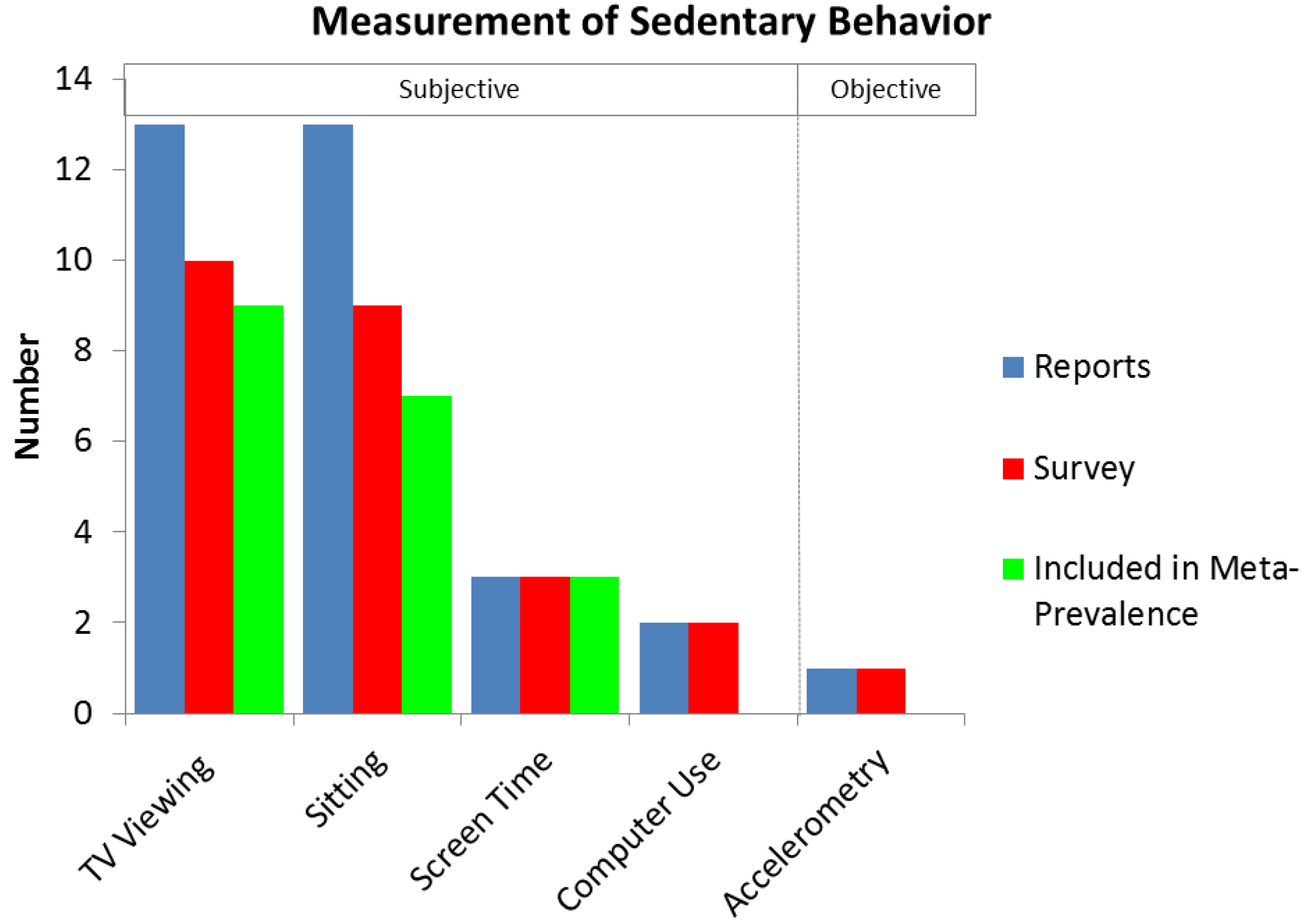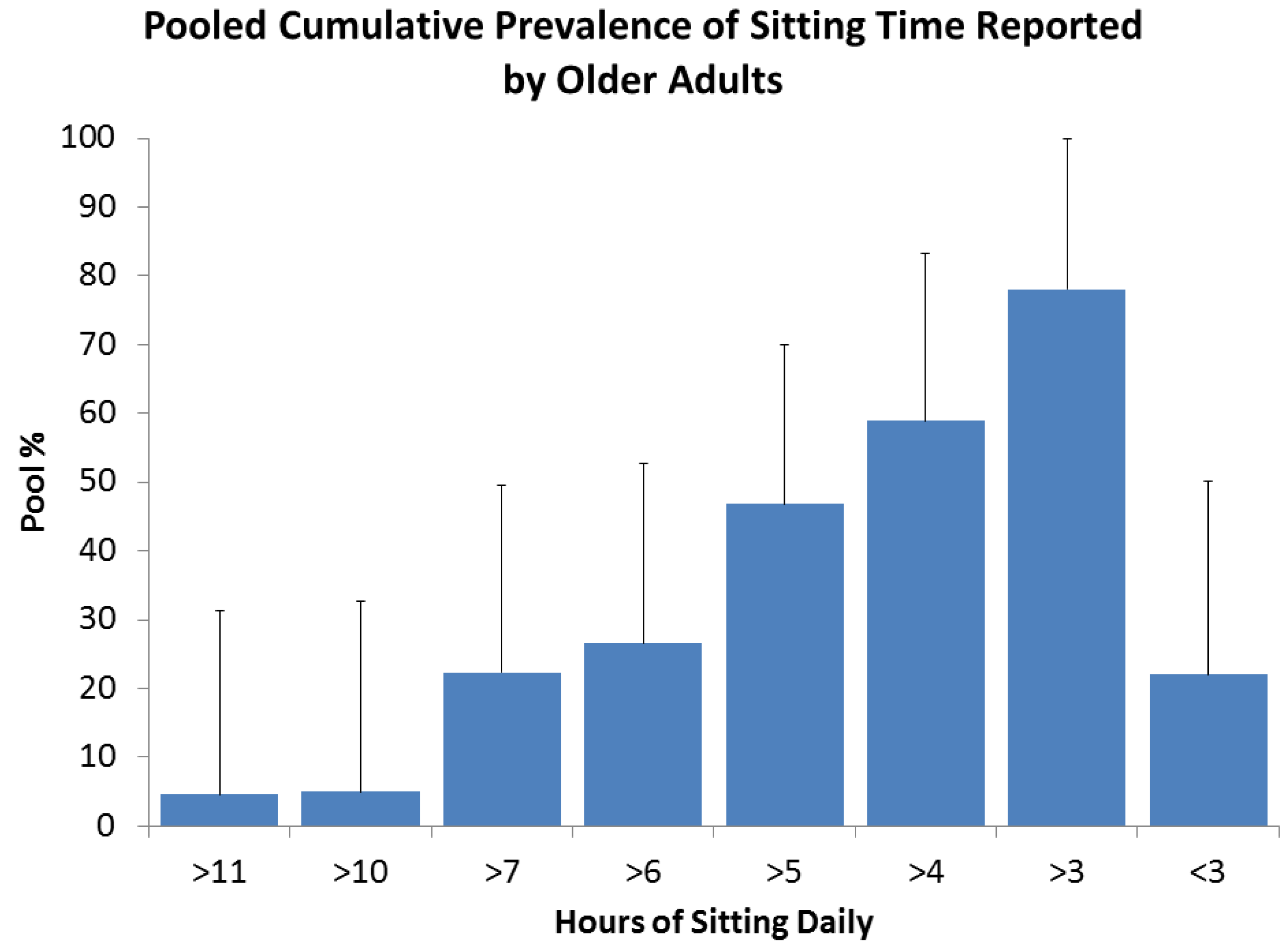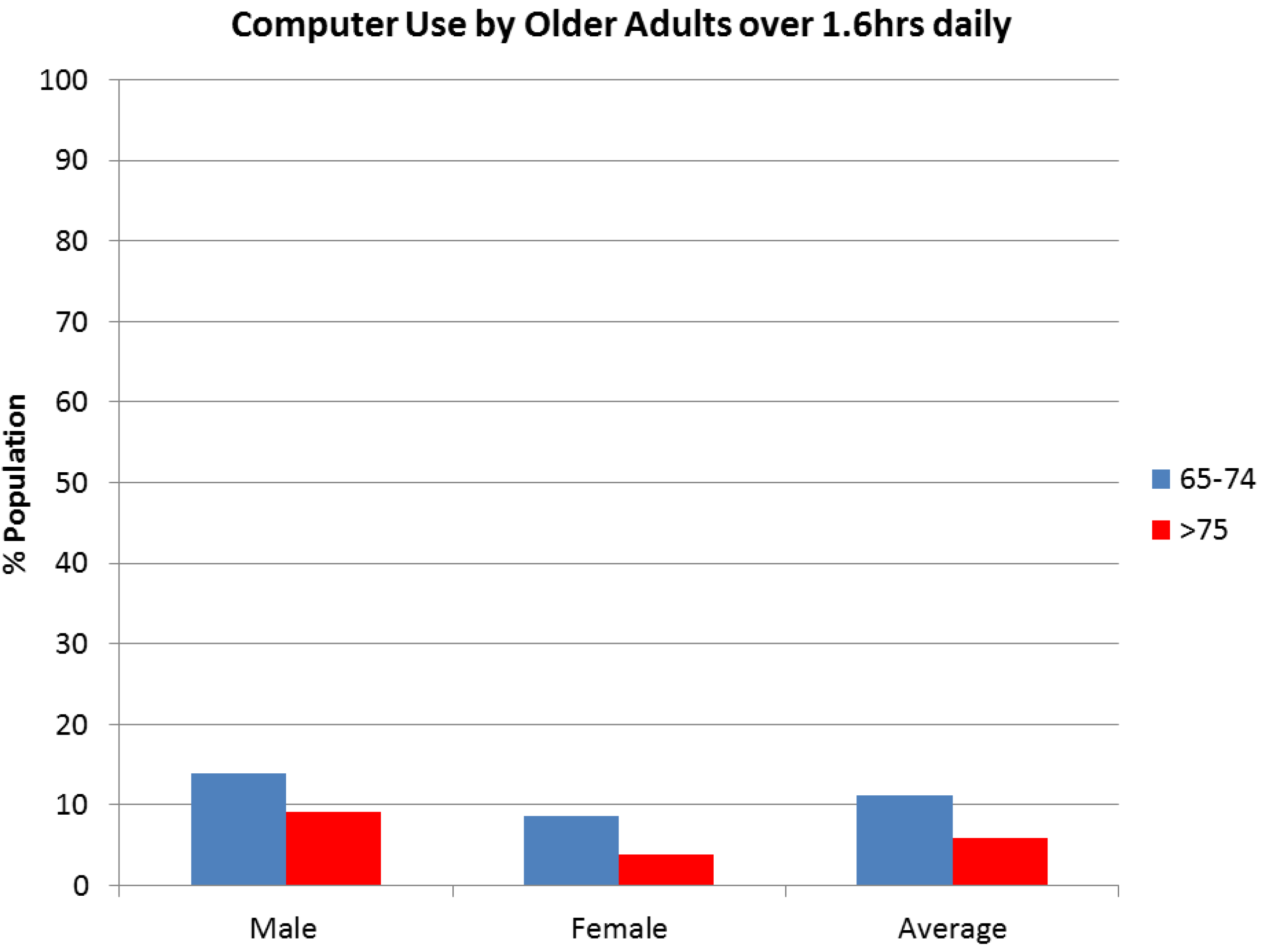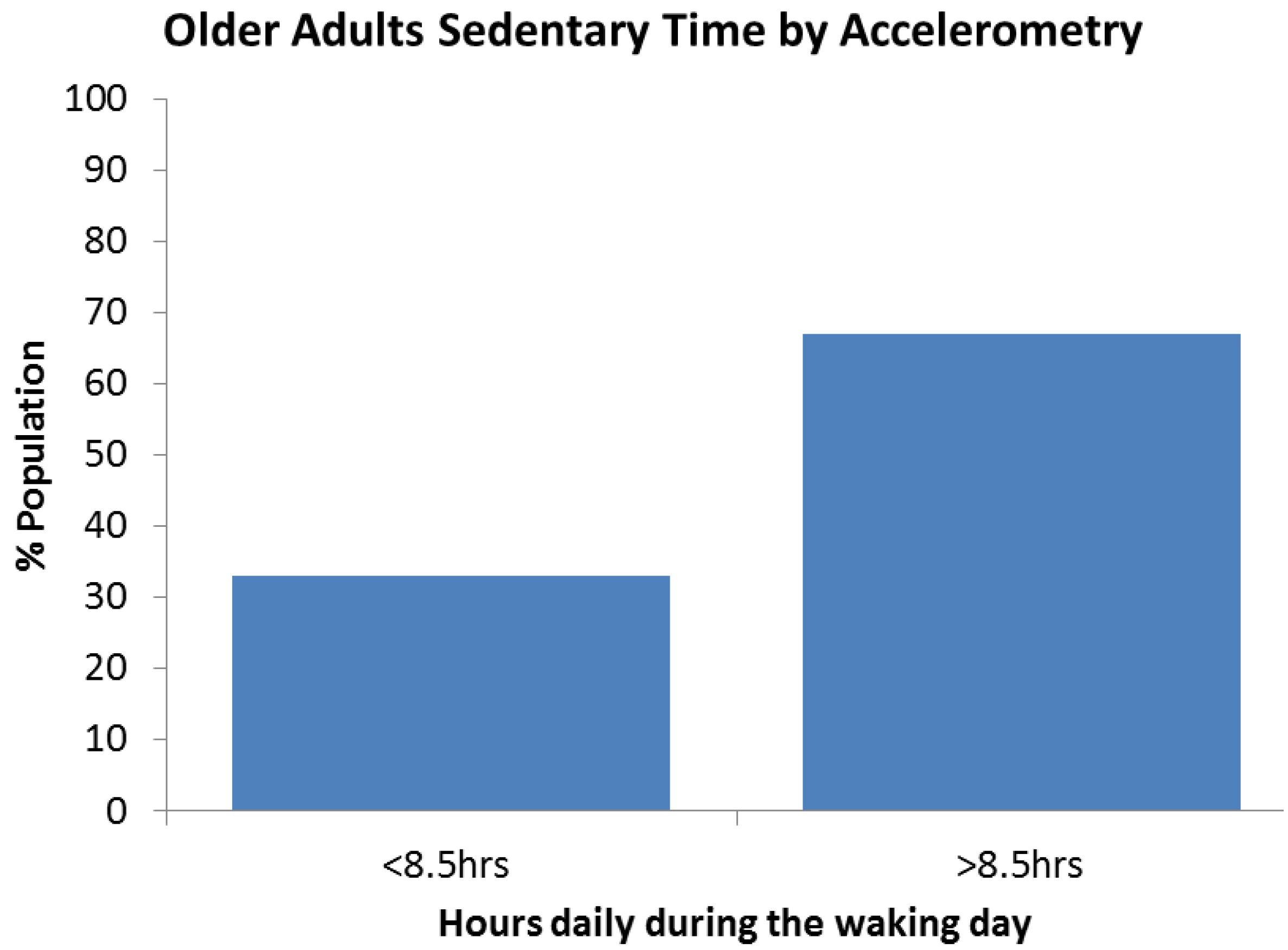Prevalence of Sedentary Behavior in Older Adults: A Systematic Review
Abstract
:1. Introduction
2. Experimental Section
2.1. Search Strategy
2.2. Inclusion and Exclusion Criteria
| Inclusion | Exclusion |
|---|---|
|
|
2.3. Methods of Data Presentation
2.3.1. The Older Adult
2.3.2. Sedentary Behavior
2.3.3. Compiling, Weighting and Pooling the Data
3. Results
3.1. Selection Process Results

3.2. Information Sources

3.3. Sedentary Behavior Surveys
| Country | Survey Name (Study Period) Study Question: Recollection Period; Reporting Period; Domain. | Authors (published date) N Older Adult (OA)/ total N, if appropriate OA Mean Age, Men (%) Measurement |
|---|---|---|
| Australia | * The Australian Diabetes Obesity and Lifestyle study (Aus Diab) (2004–2005) Face to Face Interview: Typical; Week; TV and Sitting. | Dunstan et al. (2010) [17] (Supplementary Data Provided) 1,703 > 65 years Aged: 73.1 years; ♂ 47.5% Data: Weekly TV and sitting in quartiles with gender. |
| * New South Wales Physical Activity Survey (NSW PAS) (1996) Telephone Interview: Typical; Week; TV. | Salmon et al. (2000) [19] 882 > 60 years/3,392 >18 years Mean age unknown for OA; ♂ 46.8% Data: Daily TV in 4 time categories. | |
| * 45 and Up Study (2006–2008) Postal Questionnaire: Typical; Daily; Sitting and TV watching or using a computer. | Banks et al. (2011) [18] (Supplementary Data Provided) 103,255 > 65 years Aged: 74.6 years; ♂ 51.7% Data: Daily screen time and sitting in 5 time categories with gender. | |
| * 45 and Up Study (2006–2008) Postal Questionnaire: Typical; Daily; Sitting. | Van der Ploeg et al. (2012) [20] 80,547 > 65 years/222,497 > 45 years Age Groups: 65–74 years, >75 years; ♂ 47.6% Data: Daily sitting in 4 time categories with 2 age groups | |
| Canada | * Canadian Community Health Survey (CCHS) (2008–2009) Survey Collection Method Unknown; Daily; Sitting. | Dogra and Stathokostas (2012) [3] 9,478 > 65 years/19,538 > 45 years Mean age not known for OA; ♂ 44.8% Data: Daily sitting in 3 time categories with gender. |
| * Canadian Community Health Survey (CCHS) (2007) Structured Interview: 3 months; Typical Week; TV and Computer. | Shields and Tremblay (2008) [21] 6,742 >65 years/57,617>20 years Mean age and % men not known for OA Data: Frequent TV and computer use presented as one time category with gender and age group. | |
| * Canadian Fitness Survey (CFS) (1981, baseline) Structured Interview: Most Days; Daily; Sitting. | Katzmarzyk et al. (2009) [14] 3,375 > 60 years/17,013 > 18 years Age and % men not known Data: Daily sitting in 5 time categories. | |
| Japan | * Unknown Name (February to March, 2010) Postal Questionnaire: Average; Daily and Frequency of Viewing in a Week; TV. | Ionue et al. (2012) [22] 1,806 > 65 years (up to 74) Aged: 69.2 years; ♂ 51.1% Data: Weekly TV by mean, 25th and 75th percentile. |
| * Unknown Name (February to March, 2010) Postal Questionnaire: Average; Daily and Frequency of Viewing in a Week; TV. | Kikuchi et al. (2013) [23] 1,665 > 65 years (up to 74) Aged: 69.5 years; ♂ 52% Data: Weekly TV in 2 time categories with gender | |
| Norway | ** Nord-Trøndelag Health Survey 3 (HUNT 3) (2006–2008) Self-Completing Questionnaire: Daily; Sitting, TV viewing in categories. | Chau et al. (2013) [24] 13,433 Sitting and 15,173 TV > 60 years Mean age and % men not known for OA Data: Sitting in 4 time categories; TV viewing in 3 time categories. |
| Spain | ** Unknown Name (Baseline 2001) Structured Home Interview: Daily; Sitting asked for a weekday and weekend. | Balboa-Castillo et al. (2011) [25] 1,097 > 62 years Aged: 70.3 years; ♂ 50.8% Data: Daily sitting by mean, 25th and 75th percentile. |
| ** Unknown Name (2001 and 2003) Structured Home Interview (2001); Telephone Interview (2003): Daily; Sitting asked for a weekday and weekend. | León-Muńoz et al. (2013) [26] 2,635 > 60 years Aged: 71.3 years; ♂ 43.6% Data: Sedentariness over time between 2001 and 2003 in 4 categories. | |
| UK (England and Scotland) | ** European Prospective Investigation into Cancer—Norfolk, England. (EPIC) (Baseline 1998) Self-Completing Questionnaire: Question not described. | Wijndaele et al. (2011) [16] 12,608 OA Aged: 61.4 years; ♂43.4% Data: Daily TV viewing in tertiles with gender. |
| * Health Survey England (HSE) (2008) Self-Completing: last 4 weeks; frequency and duration; TV sitting and non-TV sitting; Accelerometry: 7 days with at least one valid day, <100 counts = SB. | Stamatakis et al. (2012) [27] 2,765 > 60 years with 649 accelerometry Aged: 73.2 years; ♂ 45.4% (44.9% in accelerometry group) Data: Daily sedentary time by self-report and accelerometry in tertiles. | |
| * Scottish Health Survey (SHS) (June 2003–December 2004) Face To Face Interview: Typical day (week, then weekend); daily; TV and Other Screens. | Scottish Government (2005) [28] 1,627 > 65 years/8,148 > 18 years Age Groups: 65–74 years, >75 years; ♂ 37.7% Data: Daily screen time, weekday/weekend day, in 5 time categories, with gender. | |
| ** English Longitudinal Study of Ageing (ELSA) (2008–2009) Face To Face Interview: Ordinary week (weekday summed, weekend days summed)/7; TV. Asked if they use a computer for internet or e-mails. | Hamer and Stamatakis (2013) [29] 6,228 > 60 years Aged: 64.9 years; ♂ 45.7% Data: Daily TV time in 4 time categories; Internet use in 2 categories (yes/no) | |
| USA | ** American Cancer Society Cancer Prevention Study II Nutritional Cohort (ACS II NC) (Baseline 1992) Postal Questionnaire: Past Year; Daily; Sitting. | Patel et al. (2010) [15] 123,216 > 50 years Aged: 63.1 years; ♂ 43.4 Data: Daily sitting, 3 time categories, with gender. |
| * US Department of Agriculture Continuing Survey of Food Intake by Individuals (DACSFII) (1994–1996) Face To Face Interview: 0-24 h; Daily; TV. (asked on 2 occasions) | Bowman, (2006) [30] 1,428 > 66 years / 9,157 > 20 years Mean age and % male of OA unknown Data: Daily TV, 1 time category. | |
| * National for Institute American Association of Retired Persons Health Diet and Health Study (NIH–AARP) (Baseline: 1995–1996 population characteristics/1996–1997 sitting) Postal Questionnaire: Past Year; Daily; TV and Sitting. In addition, George et al. (2010) [29] reports—Activity in a routine day, with one sedentary response of “sitting all day”. | George et al. (2010) [31] 97,039 > 50 years Aged: 63 years (age adj); ♂ 0 Data: Daily TV and sitting in 2 time categories each. Separately, “sitting all day” number. | |
| George et al. (2011) [32] 1,206 > 50 years Aged: 63 years; ♂ 75.0% Data: Daily TV and sitting in 5 time categories each, with gender. | ||
| Matthews et al. (2012) [33] 240,819 > 60 years Aged: 62.3 years; ♂ 54.9% Data: Daily TV and sitting in 5 time categories each with gender. | ||
| * National Health and Nutrition Examination Survey (NHANES) (2003–2004, 2005–2006) Interview: Last 30 day; Daily; TV. | Clark et al. (2011) [34] 2,303 > 60 years/5,738 Age: 70.9 years; % male unknown for OA Data: Daily TV given in 1 time category. | |
| * National Health and Nutrition Examination Survey (NHANES) (1999–2002) Interview: Last 30 day; Daily; TV and computer use outside work. | Ford (2012) [35] 542 deceased at follow up in 2006 Age: 66.9 years; ♂ 64.3% Data: Screen time given in 6 time categories. |
3.4. Findings on Prevalence of Sedentary Behavior in Older Adults
3.4.1. Prevalence of Sedentary Behavior in Older Adults, by Self Report of Sitting

3.4.2. Prevalence of Sedentary Behavior in Older Adults, by Self Report of TV Viewing

3.4.3. Prevalence of Sedentary Behavior in Older Adults, by Computer Use and Screen Time


3.4.4. Prevalence of Sedentary Behavior by Accelerometry

4. Discussion
4.1. Summary of Findings
4.2. Relevance of Sedentary Behavior in Older Adults
4.3. Measurement of Sedentary Behavior in Surveys
4.4. Limitations
4.5. Future Work
5. Conclusions
Acknowledgments
Conflicts of Interest
References
- Hallal, P.C.; Andersen, L.B.; Bull, F.C.; Guthold, R.; Haskell, W.; Ekelund, U. Global physical activity levels: Surveillance progress, pitfalls, and prospects. Lancet 2012, 380, 247–257. [Google Scholar] [CrossRef]
- Katzmarzyk, P.T. Physical activity, sedentary behavior, and health: Paradigm paralysis or paradigm shift? Diabetes 2010, 59, 2717–2725. [Google Scholar] [CrossRef]
- Dogra, S.; Stathokostas, L. Sedentary behavior and physical activity are independent predictors of successful aging in middle-aged and older adults. J. Aging Res. 2012. [Google Scholar] [CrossRef]
- Thorp, A.A.; Owen, N.; Neuhaus, M.; Dunstan, D.W. Sedentary behaviors and subsequent health outcomes in adults. Am. J. Prev. Med. 2011, 41, 207–215. [Google Scholar] [CrossRef]
- Sedentary Behaviour and Obesity: Review of the Current Scientific Evidence. Available online: https://www.gov.uk/government/uploads/system/uploads/attachment_data/file/213745/dh_128225.pdf (accessed on 9 September 2013).
- Heath, G.W.; Parra, D.C.; Sarmiento, O.L.; Andersen, L.B.; Owen, N.; Goenka, S.; Montes, F.; Brownson, R.C. Evidence-based intervention in physical activity: Lessons from around the world. Lancet 2012, 380, 272–281. [Google Scholar] [CrossRef]
- Physical Activity Guidelines for Americans. Available online: http://www.health.gov/paguidelines (accessed on 9 September 2013).
- Start Active, Stay Active: A Report on Physical Activity from the Four Home Countries’ Chief Medical Officers. Available online: https://www.gov.uk/government/publications/start-active-stay-active-a-report-on-physical-activity-from-the-four-home-countries-chief-medical-officers (accessed on 9 September 2013).
- Global Recommendations on Physical Activity for Health. Available online: http://www.who.int/dietphysicalactivity/publications/9789241599979/en/index.html (accessed on 9 September 2013).
- Canadian Physical Activity Guidelines and Canadian Sedentary Behaviour Guidelines. Available online: http://www.csep.ca/english/view.asp?x=949 (accessed on 2 October 2013).
- Physical Activity Guidelines. Available online: http://www.health.gov.au/internet/main/publishing.nsf/Content/health-pubhlth-strateg-phys-act-guidelines (assessed on 20 October 2013).
- Sedentary Behaviour Research Network. Letter to the editor: Standardized use of the terms “sedentary” and “sedentary behaviours”. Appl. Physiol. Nutr. Metab. 2012, 37, 540–542. [Google Scholar] [CrossRef]
- Salmon, J.; Owen, N.; Crawford, D.; Bauman, A.; Sallis, J.F. Physical activity and sedentary behavior: A population-based study of barriers, enjoyment, and preference. Health Psychol. 2003, 22, 178–188. [Google Scholar] [CrossRef]
- Katzmarzyk, P.T.; Church, T.S.; Craig, C.L.; Bouchard, C. Sitting time and mortality from all causes, cardiovascular disease, and cancer. Med. Sci. Sports Exerc. 2009, 41, 998–1005. [Google Scholar]
- Patel, A.V.; Bernstein, L.; Deka, A.; Feigelson, H.S.; Campbell, P.T.; Gapstur, S.M.; Colditz, G.A.; Thun, M.J. Leisure time spent sitting in relation to total mortality in a prospective cohort of US adults. Am. J. Epidemiol. 2010, 172, 419–429. [Google Scholar] [CrossRef]
- Wijndaele, K.; Brage, S.; Besson, H.; Khaw, K.-T.; Sharp, S.J.; Luben, R.; Bhaniani, A.; Wareham, N.J.; Ekelund, U. Television viewing and incident cardiovascular disease: Prospective associations and mediation analysis in the EPIC Norfolk Study. PLoS One 2011, 6. [Google Scholar] [CrossRef] [Green Version]
- Dunstan, D.W.; Barr, E.L.M.; Healy, G.N.; Salmon, J.; Shaw, J.E.; Balkau, B.; Magliano, D.J.; Cameron, A.J.; Zimmet, P.Z.; Owen, N. Television viewing time and mortality: The Australian diabetes, obesity and lifestyle study (AusDiab). Circulation 2010, 121, 384–391. [Google Scholar] [CrossRef]
- Banks, E.; Jorm, L.; Rogers, K.; Clements, M.; Bauman, A. Screen-time, obesity, ageing and disability: Findings from 91,266 participants in the 45 and up study. Public Health Nutr. 2011, 14, 34–43. [Google Scholar] [CrossRef]
- Salmon, J.; Bauman, A.; Crawford, D.; Timperio, A.; Owen, N. The association between television viewing and overweight among Australian adults participating in varying levels of leisure-time physical activity. Int. J. Obes. Relat. Metab. Disord. 2000, 24, 600–606. [Google Scholar] [CrossRef]
- Van der Ploeg, H.P.; Chey, T.; Korda, R.J.; Banks, E.; Bauman, A. Sitting time and all-cause mortality risk in 222,497 Australian adults. Arch. Intern. Med. 2012, 172, 494–500. [Google Scholar] [CrossRef]
- Shields, M.; Tremblay, M.S. Screen time among Canadian adults: A profile. Health Rep. 2008, 19, 31–43. [Google Scholar]
- Inoue, S.; Sugiyama, T.; Takamiya, T.; Oka, K.; Owen, N.; Shimomitsu, T. Television viewing time is associated with overweight/obesity among older adults, independent of meeting physical activity and health guidelines. J. Epidemiol. 2012, 22, 50–56. [Google Scholar] [CrossRef]
- Kikuchi, H.; Inoue, S.; Sugiyama, T.; Owen, N.; Oka, K.; Shimomitsu, T. Correlates of prolonged television viewing time in older Japanese men and women. BMC Public Health 2013, 13. [Google Scholar] [CrossRef]
- Chau, J.Y.; Grunseit, A.; Midthjell, K.; Holmen, J; Holmen, T.L.; Bauman, A.E.; van der Ploeg, H.P. Sedentary behaviour and risk of mortality from all-causes and cardiometabolic diseases in adults: Evidence from the HUNT3 population cohort. Br. J. Sports Med. 2013. [Google Scholar] [CrossRef]
- Balboa-Castillo, T.; León-Muñoz, L.M.; Graciani, A.; Rodríguez-Artalejo, F.; Guallar-Castillón, P. Longitudinal association of physical activity and sedentary behavior during leisure time with health-related quality of life in community-dwelling older adults. Health Qual. Life Outcomes 2011, 9. [Google Scholar] [CrossRef]
- León-Muñoz, L.M.; Martínez-Gómez, D.; Balboa-Castillo, T.; López-García, E.; Guallar-Castillón, P.; Rodríguez-Artalejo, F. Continued sedentariness, change in sitting time, and mortality in older adults. Med. Sci. Sports Exerc. 2013, 45, 1501–1507. [Google Scholar] [CrossRef]
- Stamatakis, E.; Davis, M.; Stathi, A.; Hamer, M. Associations between multiple indicators of objectively-measured and self-reported sedentary behaviour and cardiometabolic risk in older adults. Prev. Med. 2012, 54, 82–87. [Google Scholar] [CrossRef]
- The Scottish Health Survey 2003. Available online: http://www.scotland.gov.uk/Publications/2005/12/02160336/03367 (accessed on 16 August 2013).
- Hamer, M.; Stamatakis, E. Screen-based sedentary behavior, physical activity and muscle strength in the English longitudinal study of ageing. PLoS One 2013, 8. [Google Scholar] [CrossRef] [Green Version]
- Bowman, S.A. Television-viewing characteristics of adults: Correlations to eating practices and overweight and health status. Prev. Chronic Dis. 2006, 3, A38. [Google Scholar]
- George, S.M.; Irwin, M.L.; Matthews, C.E.; Mayne, S.T.; Gail, M.H.; Moore, S.C.; Albanes, D.; Ballard-Barbash, R.; Hollenbeck, A.R.; Schatzkin, A.; Leitzmann, M.F. Beyond recreational physical activity: Examining occupational and household activity, transportation activity, and sedentary behavior in relation to postmenopausal breast cancer risk. Am. J. Public Health 2010, 100, 2288–2295. [Google Scholar] [CrossRef]
- George, S.M.; Moore, S.C.; Chow, W.-H.; Schatzkin, A.; Hollenbeck, A.R.; Matthews, C.E. A prospective analysis of prolonged sitting time and risk of renal cell carcinoma among 300,000 older adults. Ann. Epidemiol. 2011, 21, 787–790. [Google Scholar] [CrossRef]
- Matthews, C.E.; George, S.M.; Moore, S.C.; Bowles, H.R.; Blair, A.; Park, Y.; Troiano, R.P.; Hollenbeck, A.; Schatzkin, A. Amount of time spent in sedentary behaviors and cause-specific mortality in US adults. Am. J. Clin. Nutr. 2012, 95, 437–445. [Google Scholar] [CrossRef]
- Clark, B.K.; Healy, G.N.; Winkler, E.A.H.; Gardiner, P.A.; Sugiyama, T.; Dunstan, D.W.; Matthews, C.E.; Owen, N. Relationship of television time with accelerometer-derived sedentary time: NHANES. Med. Sci. Sports Exerc. 2011, 43, 822–828. [Google Scholar]
- Ford, E.S. Combined television viewing and computer use and mortality from all-causes and diseases of the circulatory system among adults in the United States. BMC Public Health 2012, 12. [Google Scholar] [CrossRef]
- Stamatakis, E.; Hamer, M.; Tilling, K.; Lawlor, D.A. Sedentary time in relation to cardio-metabolic risk factors: Differential association for self-report vs. accelerometry in working age adults. Int. J. Epidemiol. 2012, 41, 1328–1337. [Google Scholar] [CrossRef]
- Celis-Morales, C.A.; Perez-Bravo, F.; Ibńez, L.; Salas, C.; Bailey, M.E.S.; Gill, J.M.R. Objective vs. self-report physical activity and sedentary time: Effects of measurement method on relationship with risk biomarkers. PLoS One 2012, 7. [Google Scholar] [CrossRef]
- Van Uffelen, J.G.Z.; Heesch, K.C.; Hill, R.L.; Brown, W.J. A qualitative study of older adults’ response to sitting-time questions: Do we get the information we want? BMC Public Health 2011, 11. [Google Scholar] [CrossRef] [Green Version]
- Barendregt, J.J.; Doi, S.A.; Lee, Y.Y.; Norman, R.E.; Vos, T. Meta-analysis of Prevalence. J. Epidemiol. Community Health 2013, 67, 974–978. [Google Scholar]
Supplementary Files
© 2013 by the authors; licensee MDPI, Basel, Switzerland. This article is an open access article distributed under the terms and conditions of the Creative Commons Attribution license (http://creativecommons.org/licenses/by/3.0/).
Share and Cite
Harvey, J.A.; Chastin, S.F.M.; Skelton, D.A. Prevalence of Sedentary Behavior in Older Adults: A Systematic Review. Int. J. Environ. Res. Public Health 2013, 10, 6645-6661. https://doi.org/10.3390/ijerph10126645
Harvey JA, Chastin SFM, Skelton DA. Prevalence of Sedentary Behavior in Older Adults: A Systematic Review. International Journal of Environmental Research and Public Health. 2013; 10(12):6645-6661. https://doi.org/10.3390/ijerph10126645
Chicago/Turabian StyleHarvey, Juliet A., Sebastien F. M. Chastin, and Dawn A. Skelton. 2013. "Prevalence of Sedentary Behavior in Older Adults: A Systematic Review" International Journal of Environmental Research and Public Health 10, no. 12: 6645-6661. https://doi.org/10.3390/ijerph10126645
APA StyleHarvey, J. A., Chastin, S. F. M., & Skelton, D. A. (2013). Prevalence of Sedentary Behavior in Older Adults: A Systematic Review. International Journal of Environmental Research and Public Health, 10(12), 6645-6661. https://doi.org/10.3390/ijerph10126645






